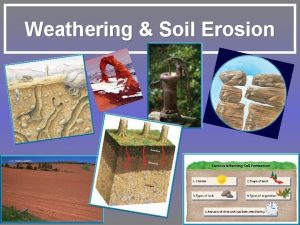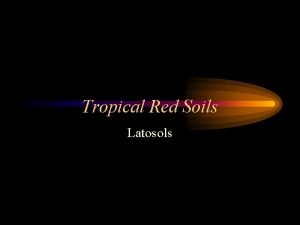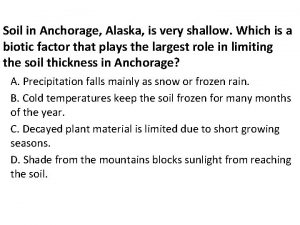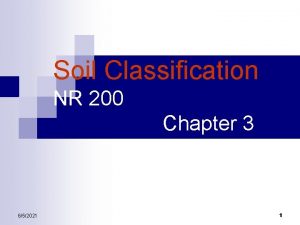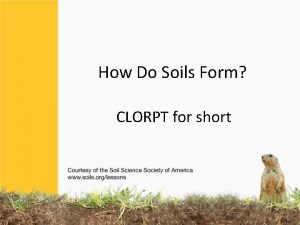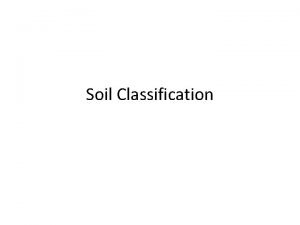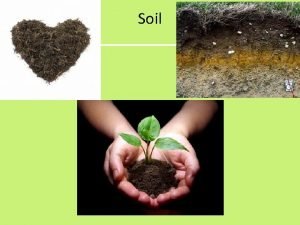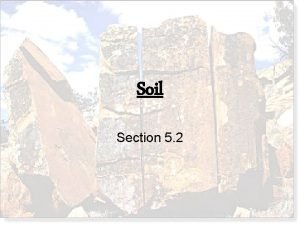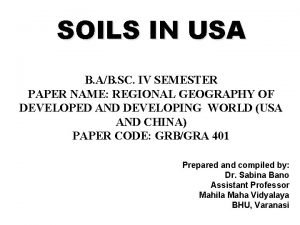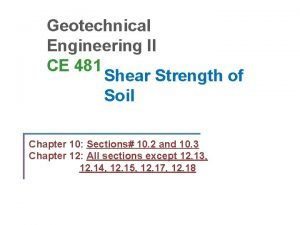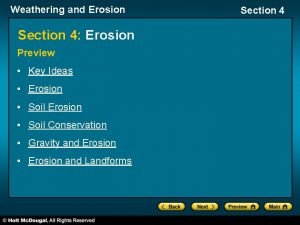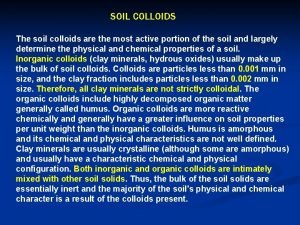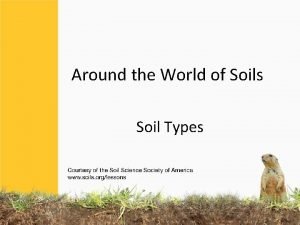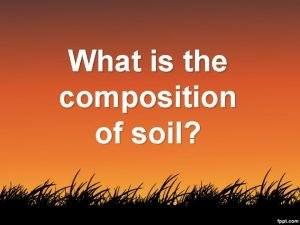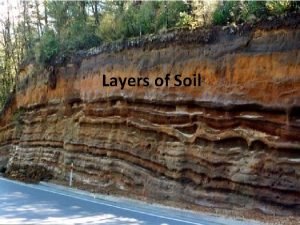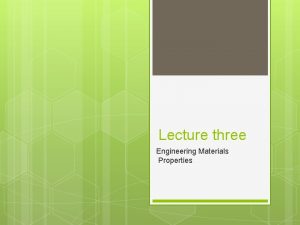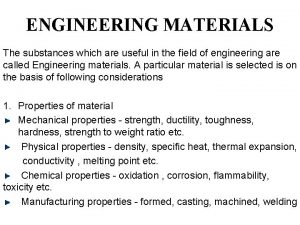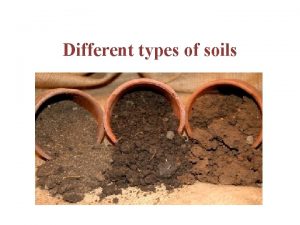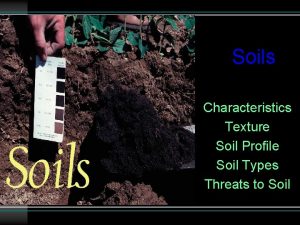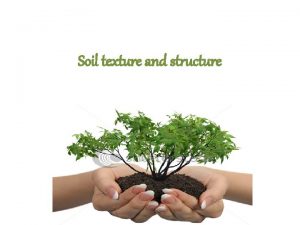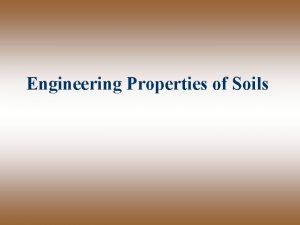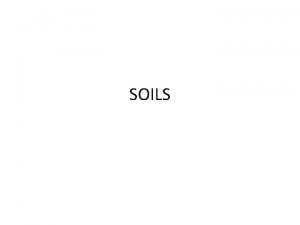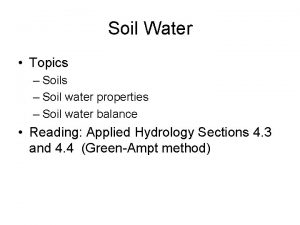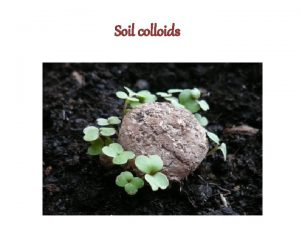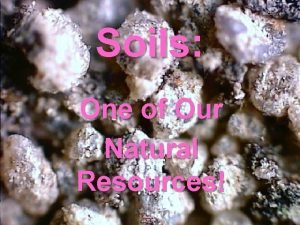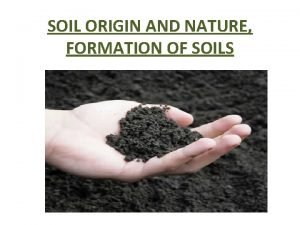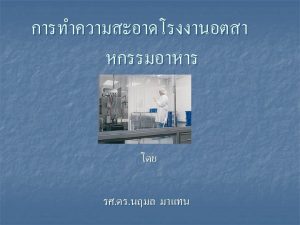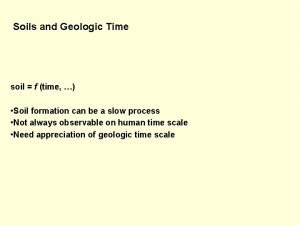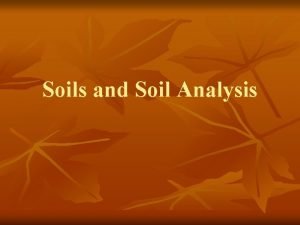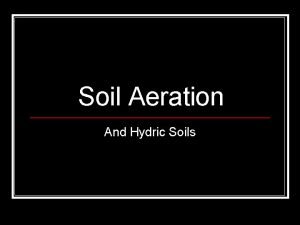Engineering Properties of Soils Soil Types Engineering Properties

































- Slides: 33

Engineering Properties of Soils Soil Types • Engineering Properties of Soils – foundation for the project – construction material (road embankments, earth dams) • Soil Definition (Engineering) – “refers to all unconsolidated material in the earth’s crust, all material above bedrock” • mineral particles (sands, silts, clays) • organic material (topsoil, marshes) + air + water Soils ENCI 579 1

Engineering Properties of Soils Soil Types • Mineral Soil Particles – weathering of rock from the crust of the earth – physical weathering and chemical weathering • Physical Weathering – action of frost, water, wind, glaciers, plant/animals, etc. breaking particles away from original bedrock – particles transported by wind, water, ice >rounding and reducing their size – soils formed are called granular soil type Soils ENCI 579 2 – “grains are similar to the original bedrock”

Engineering Properties of Soils Soil Types • Chemical weathering – occurs when water flows through rocks and leaches out some of the mineral components of the rock – soils formed are called clays – “clay particles are mineral crystals that have very different properties from those of the original bedrock” Soils ENCI 579 3

Engineering Properties of Soils Mineral Soils ENCI 579 4

Engineering Properties of Soils Soil Types • Granular and Cohesive soil types – difference in engineering properties result from the large variation in size and shape of the grains • Cohesive soil type (clays) – grains are extremely small and flat • the mass of a grain as a force is negligible when compared to the forces resulting from the surface properties of the grain Soils ENCI 579 5

Engineering Properties of Soils Soil Types • Water Holding Capacity of Clays – Shrinkage • evaporation of exposed clays • loading – Expansion • dry side may absorb moisture • Structure of Clays – deposited by settling out in lakes Soils ENCI 579 6

Engineering Properties of Soils Soil Types • Structure of Clays – surface charges forces grains to edge to side pattern – flocculent structure as opposed to granular soils which are deposited in a denser configuration because the force of gravity on the mass of these grains is more important Soils ENCI 579 7

Engineering Properties of Soils Soil Types • Clays have surface charges due to the very large surface area per gram of material • Chemical composition results in: – negative charges along the sides of a grain – positive charges at the ends of a grain clay grain • Results of these surface properties – water holding capacity of clays surface charges attract water – structure of clay deposits Soils ENCI 579 8

Engineering Properties of Soils Soil Types Soils ENCI 579 9

Engineering Properties of Soils Soil Types • Clay Soils – Small flat shape – Negative/positive surface charges – Bound water on the surface – Different clay minerals are different in size – Swelling clays absorb water into the crystal lattice – Shrinkage due to evaporation or loading Soils ENCI 579 10

Engineering Properties of Soils Soil Types • Granular Soils – Larger grain sizes than clays – Particles tend to be more or less spheres/cubes – Bound water is small compared to overall mass – Silt particles may not be visible to eye but tend to be gritty, have dull appearance and lack cohesion when dry Soils ENCI 579 11

Engineering Properties of Soils Soil Types • Organic Soils – Tend to be fibrous and/or amorphous – Brown to Black in color – High moisture holding capacity – Water may run out when squeezed – Dried organic soils may combust Soils ENCI 579 12

Engineering Properties of Soils Soil Types • • Silts are coarser than clays and not bond tightly together Silts are gritty, less plastic and dull when cut Dry Strength-silts loose “apparent cohesion” when dried Shaking test-saturated silt samples become denser water seeps to the surface - “dilantancy” Soils ENCI 579 13

Engineering Properties of Soils Mass-Volume Relationships Soils ENCI 579 14

Engineering Properties of Soils Mass-Volume Relationships Example 1 -2 Given: A soil sample has a volume Mw = M - MD = 70 g of 175 cm 3 and a total MD = 230 g mass of 300 g. Mass Air M = 300 g when dried is 230 g. Water V = 175 cm 3 Relative density of the soil solids is 2. 70. Find r, r. D, w, e, S and n Soils ENCI 579 Solids 15

Engineering Properties of Soils Mass-Volume Relationships Calculations: Vw = Mw/rw = 70 g/(1 g/cm 3) =70 cm 3 VD = MD/(RD x rw) = 230 g/(2. 70 x 1 g/cm 3) = 85 cm 3 VA = V- (VD + Vw ) = 175 - 155 = 20 cm 3 Soils ENCI 579 VA = 20 cm 3 VW = 70 cm 3 VD = 85 cm 3 V = 175 cm 3 16

Engineering Properties of Soils Mass-Volume Relationships Answer: r = M/V = 300 g/175 cm 3 = 1. 71 g/cm 3 r. D = MD/V = 230 g/175 cm 3 = 1. 31 g/cm 3 w = Mw / MD = 70 g/230 g = 30. 4 % e = Vv / VD = 90 cm 3/85 cm 3 = 1. 06 S = VW /Vv = 70 cm 3/90 cm 3 = 78 % n = Vv /V = 90 cm 3/ 175 cm 3 = 51 % Soils ENCI 579 17

Engineering Properties of Soils Mass-Volume Relationships - Rules 1. Density is given assume total unit volume 1 cm 3 or 1 m 3 2. Water content is given along with total density or total mass. Use MD = M or r. D = r 1+w 3. Void Ratio is given and RD assume a unit volume of soil solids VD = 1 m 3 Soils ENCI 579 18

Engineering Properties of Soils Mass-Volume Relationship • Density Index – Field soil condition referred to as loose or dense – Density Index is insitu soil’s density relative to the maximum and minimum for that type of soil – Assessing the stability of granular soils – Known as relative density – ID = r DRY MAX x r D - r DRY MIN r. D r DRY MAX - r DRY MIN Soils ENCI 579 19

Engineering Properties of Soils ENCI 579 20

Engineering Properties of Soils Classification Tests • Two types of tests used in classifying soils – Grain size, measures grain sizes – Plasticity, measures grain types • Grain Size – grain size distribution curve • Sieve analysis gravel and sand • Hydrometer test for silt and clay Soils ENCI 579 21

Engineering Properties of Soils Classification Tests • Hydrometer Test – Used to find the size of smaller grains to plot a grain size distribution curve – Stokes Law • particles in suspension settle out at a rate which varies with their size • hydrometer measures the density of a soil-water mix at various times as the grain settles • The size of particle to the center of the bulb can be calculated and density of the solution indicates the percentage of the sample still in solution Soils ENCI 579 22

Engineering Properties of Soils Sieve Analysis Soils ENCI 579 23

Engineering Properties of Soils Classification Tests Soils ENCI 579 24

Engineering Properties of Soils Classification Tests • Grain Size Distribution Curve – Shape • Uniform soil is composed of mainly one size grain • Well graded soil contains a wide range of grain sizes – Effective Size • Effective size is the grain size that only 10% of the grain sizes are finer than. • The amount and type of fine grains in a soil are important in assessing the properties of that soil Soils ENCI 579 25

Engineering Properties of Soils Classification Tests • Grain Size Distribution Curve – Uniformity Coefficient Cu • indication of the shape of the curve and range of particle sizes that the soil contains • Cu = D 60 / D 10 – Coefficient of Curvature Cc • indication of the shape of the curve. • Cc = (D 30)2 / (D 60 x D 10) Soils ENCI 579 26

Engineering Properties of Soils Classification Tests • Curve A Uniform Soil • Curve B - Well Graded Soil • Soil B Soils ENCI 579 – Effective size =. 09 mm – Cu = 7/. 09=78 – Cc = 1. 12/(7 x. 09)=1. 927

Engineering Properties of Soils Classification Tests – Textural Classification • based entirely on grain size – ASTM System • • Gravel Sand Silt Clay larger than 4. 75 mm (No. 4) 4. 75 mm - 0. 075 mm (No. 4 -No. 200) 0. 075 mm - 0. 005 mm smaller than 0. 005 mm – Identify % of the grains as classified Soils ENCI 579 28

Engineering Properties of Soils Classification Tests Soils ENCI 579 29

Engineering Properties of Soils Classification Tests • Plasticity Test (grain type) • Measures the amount of water that a soil absorbs – Plastic Limit • w/c where the soil behaves like a plastic material – Liquid Limit • w/c where the soil behaves more like a liquid – Plasticity Index (Atterberg Limits Test) • the range of w/c’s where soil is plastic Soils ENCI 579 30

Engineering Properties of Soils Classification Tests Soils ENCI 579 31

Engineering Properties of Soils Classification Tests • Atterberg Limits test measures the consistency of the soil deposit – Soil A: Wp=25 Wl=32 w/c=35 – Soil B: Wp=40 Wl=80 w/c=45 • Atterberg Limits Test – soil rolled into a thread Wp – soil flow measured in a cup Wl Soils ENCI 579 32

Engineering Properties of Soils Soil Classification • Unified Soil Classification ASTM D 2487 – general engineering purposes • AASHTO Soil Classification – highway engineering purposes – classifies soils to it’s suitability as a subgrade Soils ENCI 579 33
 Living soil vs dead soil
Living soil vs dead soil Living soil vs dead soil
Living soil vs dead soil Weathering and soil erosion
Weathering and soil erosion Tropical red soils
Tropical red soils Soils alive
Soils alive The finest-grained soils are richest in
The finest-grained soils are richest in Prairie soils (mollisols) are _______.
Prairie soils (mollisols) are _______. Timbering in dry loose soils
Timbering in dry loose soils Clorpt
Clorpt Classification of soils
Classification of soils How does the study of soils help evaluate natural hazards?
How does the study of soils help evaluate natural hazards? Components of soil
Components of soil Which is not true of laterite soils
Which is not true of laterite soils A nation that destroys its soil destroys itself
A nation that destroys its soil destroys itself Ashley soils
Ashley soils Pedalfers
Pedalfers Expansive soil properties
Expansive soil properties Shear strength of soil in geotechnical engineering
Shear strength of soil in geotechnical engineering Weathering and soil erosion
Weathering and soil erosion Types of soil colloids
Types of soil colloids Soil types in ireland
Soil types in ireland Formation of sedimentary rocks leaving cert
Formation of sedimentary rocks leaving cert Soil classification types
Soil classification types It is the process of removing food
It is the process of removing food 12 soil types
12 soil types Soil texture triangle activity
Soil texture triangle activity Layers of soil
Layers of soil 3 layers of soil
3 layers of soil Intensive property and extensive properties
Intensive property and extensive properties Physical properties and chemical properties
Physical properties and chemical properties Socio technical system in software engineering
Socio technical system in software engineering Optical properties of engineering materials
Optical properties of engineering materials Properties of engineering materials
Properties of engineering materials Scattering matrix for a lossless network is
Scattering matrix for a lossless network is


